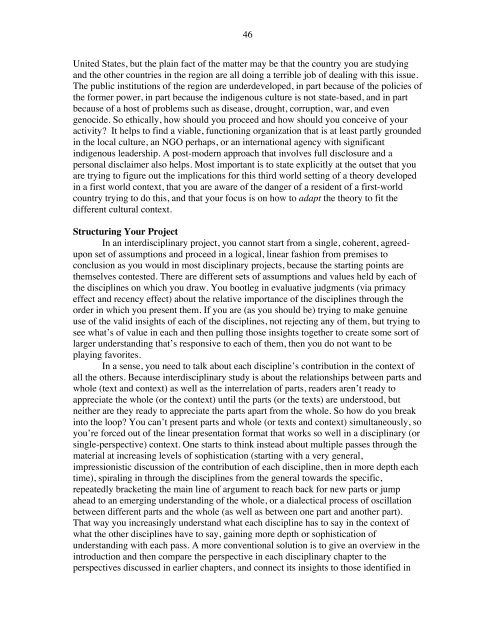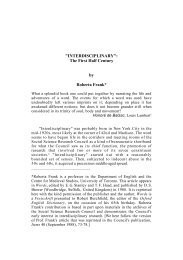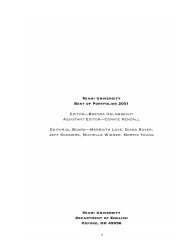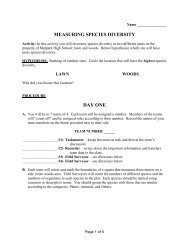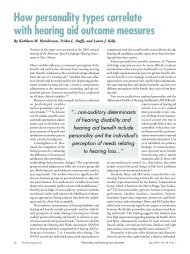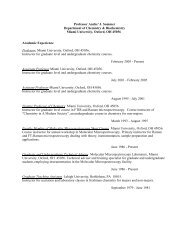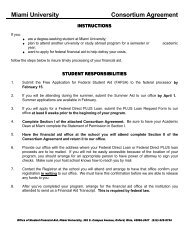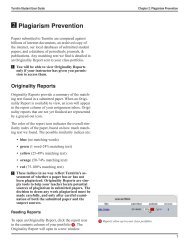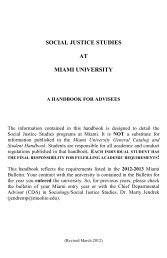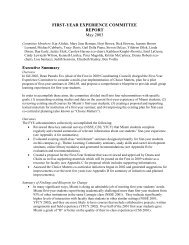Interdisciplinary Research Manual - Units.muohio.edu
Interdisciplinary Research Manual - Units.muohio.edu
Interdisciplinary Research Manual - Units.muohio.edu
Create successful ePaper yourself
Turn your PDF publications into a flip-book with our unique Google optimized e-Paper software.
46<br />
United States, but the plain fact of the matter may be that the country you are studying<br />
and the other countries in the region are all doing a terrible job of dealing with this issue.<br />
The public institutions of the region are underdeveloped, in part because of the policies of<br />
the former power, in part because the indigenous culture is not state-based, and in part<br />
because of a host of problems such as disease, drought, corruption, war, and even<br />
genocide. So ethically, how should you proceed and how should you conceive of your<br />
activity? It helps to find a viable, functioning organization that is at least partly grounded<br />
in the local culture, an NGO perhaps, or an international agency with significant<br />
indigenous leadership. A post-modern approach that involves full disclosure and a<br />
personal disclaimer also helps. Most important is to state explicitly at the outset that you<br />
are trying to figure out the implications for this third world setting of a theory developed<br />
in a first world context, that you are aware of the danger of a resident of a first-world<br />
country trying to do this, and that your focus is on how to adapt the theory to fit the<br />
different cultural context.<br />
Structuring Your Project<br />
In an interdisciplinary project, you cannot start from a single, coherent, agre<strong>edu</strong>pon<br />
set of assumptions and proceed in a logical, linear fashion from premises to<br />
conclusion as you would in most disciplinary projects, because the starting points are<br />
themselves contested. There are different sets of assumptions and values held by each of<br />
the disciplines on which you draw. You bootleg in evaluative judgments (via primacy<br />
effect and recency effect) about the relative importance of the disciplines through the<br />
order in which you present them. If you are (as you should be) trying to make genuine<br />
use of the valid insights of each of the disciplines, not rejecting any of them, but trying to<br />
see what’s of value in each and then pulling those insights together to create some sort of<br />
larger understanding that’s responsive to each of them, then you do not want to be<br />
playing favorites.<br />
In a sense, you need to talk about each discipline’s contribution in the context of<br />
all the others. Because interdisciplinary study is about the relationships between parts and<br />
whole (text and context) as well as the interrelation of parts, readers aren’t ready to<br />
appreciate the whole (or the context) until the parts (or the texts) are understood, but<br />
neither are they ready to appreciate the parts apart from the whole. So how do you break<br />
into the loop? You can’t present parts and whole (or texts and context) simultaneously, so<br />
you’re forced out of the linear presentation format that works so well in a disciplinary (or<br />
single-perspective) context. One starts to think instead about multiple passes through the<br />
material at increasing levels of sophistication (starting with a very general,<br />
impressionistic discussion of the contribution of each discipline, then in more depth each<br />
time), spiraling in through the disciplines from the general towards the specific,<br />
repeatedly bracketing the main line of argument to reach back for new parts or jump<br />
ahead to an emerging understanding of the whole, or a dialectical process of oscillation<br />
between different parts and the whole (as well as between one part and another part).<br />
That way you increasingly understand what each discipline has to say in the context of<br />
what the other disciplines have to say, gaining more depth or sophistication of<br />
understanding with each pass. A more conventional solution is to give an overview in the<br />
introduction and then compare the perspective in each disciplinary chapter to the<br />
perspectives discussed in earlier chapters, and connect its insights to those identified in


